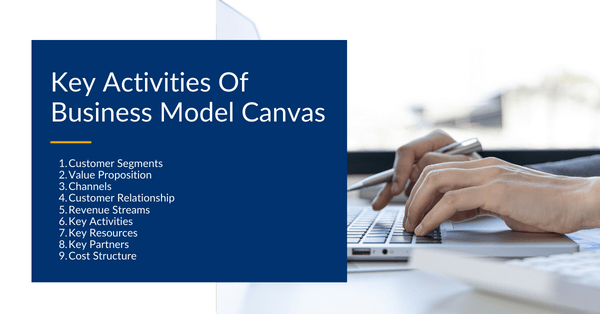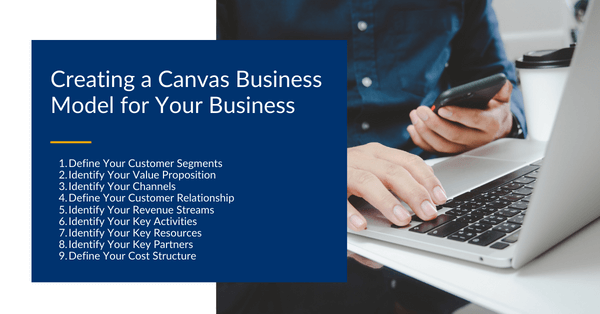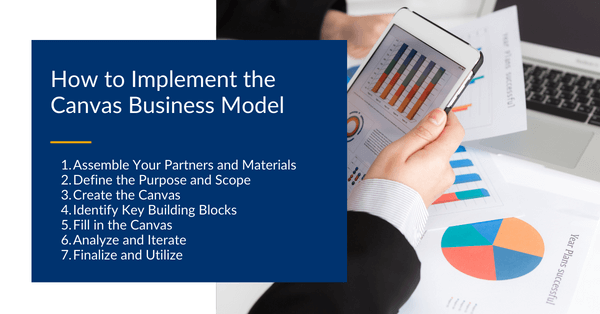The canvas business model has been around for a while but it is being used by more and more businesses. It’s a simple model and can be used by both large and small businesses. In this blog, we are going to look at what the canvas business model is all about. We will look at what the canvas business model does, and how it can benefit businesses and we will look at how you can set up a canvas business model to help your business grow.
What is a Canvas Business Model
The Canvas business model is a powerful tool for startups and business owners. It enables you to visualize, design & reinvent your company’s market strategy in one easy step! The Swiss theorist Alexander Osterwalder developed this innovative approach which helps entrepreneurs identify their unique value proposition as well as where they need focus efforts when starting out or growing an existing enterprise – all without having any prior knowledge about how different components come together at first glance
Key Activities Of Canvas Business Model
We talked about it in our blog here. But in case you missed it here are the key activities of the Canvas Business Model

1. Customer Segments
The first step is to understand who your customers are. Who are you resolving a problem for, or fulfilling a special need? You need to understand them well. What do they need, want, like, and feel? I would advise you before you start filling this in, to do some market research around your customers’ needs so you are crystal clear on your customer’s needs and wants, so you can tailor your business around resolving their problems and challenges.
2. Value Proposition
So if you have done some market research about your customers, you should know all about what they are struggling with, what are their problems and challenges are. This will help you get clear on what value you are going to deliver to the customer. What problems and challenges are you helping to solve? And what things do you have to offer them for a customer to pick you over your competitor?
3. Channels
Channels are all about where you are communicating with your customers. What platforms are you using to reach out to them? Do you have a website, e-commerce store, social media profile, email marketing platform? Write them all down here. And remember you don’t need to be active on all of these platforms. Choose the ones that work the best for you and your customer.
4. Customer Relationship
Customer relationships will help you get clear on what type of relationship you have with your customers. How do your customers interact with you from the moment they get interested in your offer, to the time they make a purchase? Is the communication strictly online, is there a dedicated person or a team to manage your customer relationships?
5. Revenue Streams
This is all about how your business makes money. What are your customers willing to pay for and how does that add up to your revenue? For instance, if you are a coach, are you offering online training materials, and 1:1 coaching sessions, for your services? How are you planning to make money with your business?
6. Key Activities
Key activities are related to your value proposition. What are the key things you need to do in your business in order to deliver the best possible value to your customers? If you are a business coach, problem-solving and customer service will be the key activities you want to focus on to make your customers happy.
7. Key Resources
What resources does your company require to bring your business to life? Do you need physical resources like buildings, vehicles, or machines? Or do you need intellectual resources around building your brand, proprietary knowledge, or creating partnerships? Or do you need human resources to manage your business, or maybe financial help in terms of cash or credit?
8. Key Partners
Key partners are the relationships that you have with other businesses that will help you deliver value to your customers. What external partners do you need to perform your key activities? If you are selling physical products, who are your key suppliers?
9. Cost Structure
The final element of the Canvas Business Model is the cost structure. This outlines the costs that your business incurs in order to carry out its key activities. By identifying your cost structure, you can ensure that your business takes advantage of resources efficiently and is maximizing its profitability.
Creating a Canvas Business Model for Your Business
Now that we understand the key elements of the Canvas Business Model let’s take a look at how to create a Canvas Business Model for your own business.

1. Define Your Customer Segments
The first step in creating a Canvas Business Model is to define your customer segments. Start by identifying the specific groups of customers that your business targets. This will help you tailor your products and services to meet their specific needs and preferences.
2. Identify Your Value Proposition
The second step in creating a Canvas Business Model is to identify your value proposition. This is the unique value that your business offers to your customers. By identifying your value proposition, you can differentiate your business from your competitors and create a compelling reason for customers to choose your products or services.
3. Identify Your Channels
The third step in creating a Canvas Business Model is to identify your channels. These is the various channels that you use to reach your customers. By identifying your channels, you can ensure that your products and services are reaching your target audience through the most effective channels.
4. Define Your Customer Relationships
The fourth step in creating a Canvas Business Model is to define your customer relationships. This outlines the types of relationships that your business has with your customers. By identifying your customer relationships, you can tailor your customer service and support to meet their specific needs and preferences.
5. Identify Your Revenue Streams
The fifth step in creating a Canvas Business Model is to identify your revenue streams. This outlines the different ways that your business generates revenue. By identifying your revenue streams, you can optimize your pricing strategy and ensure that your business generates revenue through the most profitable channels.
6. Identify Your Key Activities
The sixth step in creating a Canvas Business Model is to identify your key activities. This outlines the specific activities that your business needs to carry out in order to be successful. By identifying your key activities, you can ensure that your business focuses on the most important tasks and is using its resources efficiently.
7. Identify Your Key Resources
The seventh step in creating a Canvas Business Model is to identify your key resources. This outlines the resources that your business needs in order to carry out its key activities. By identifying your key resources, you can ensure that your business has the resources it needs to be successful and is using them efficiently.
8. Identify Your Key Partnerships
The eighth step in creating a Canvas Business Model is to identify your key partnerships. This outlines the partnerships that your business needs in order to be successful. By identifying your key partnerships, you can ensure that your business works with the right partners and is leveraging their resources and expertise effectively.
9. Define Your Cost Structure
The final step in creating a Canvas Business Model is to define your cost structure. This outlines the costs that your business incurs in order to carry out its key activities. By identifying your cost structure, you can ensure that your business uses its resources efficiently and is maximizing its profitability.
How to Implement the Canvas Business Model
A business model canvas is a powerful tool for visualizing and analyzing the fundamental aspects of your business.Creately uses these steps to create a comprehensive business model canvas:

1. Assemble Your Partners and Materials
Bring together a diverse group of people from your company to collaborate on the business model canvas. Having different perspectives will ensure that all aspects of the business are covered. While you can use traditional tools like whiteboards, sticky notes, and markers, consider using an online platform for easy access and collaboration.
2. Define the Purpose and Scope
Clearly articulate the purpose and scope of the business model canvas. Determine the specific business or idea you want to analyze and visualize with your partners and set the context accordingly.
3. Create the Canvas
Divide your workspace into nine equal sections, each representing one of the essential building blocks of the business model canvas.
4. Identify Key Building Blocks
5. Fill in the Canvas
Collaborate with your partners to fill in each section of the business model canvas with relevant and accurate information. Use data, keywords, diagrams, and other visual aids to represent ideas and concepts effectively.
6. Analyze and Iterate
Once the canvas is completed, analyze the relationships between different building blocks to identify strengths, weaknesses, opportunities, and challenges. Encourage open discussions within the team to suggest improvements and make necessary adjustments to the canvas.
7. Finalize and Utilize
Finalize the business model canvas and use it as a visual reference to communicate and align your business model with stakeholders. The canvas will serve as a guide to make informed and strategic decisions and steer your business in the right direction.
Creating a business model canvas is an iterative process, and it’s essential to review and update it regularly as your business evolves and adapts to changing market conditions and customer needs.
Mistakes to avoid when creating the canvas business model
Sometimes creating a canvas business model can actually cause more harm than good. Sometimes, they don’t run it through an exercise at all. Below are five crucial mistakes to avoid when creating a business model canvas.

1. Failing to research the target market
To craft a successful business model canvas, the initial step involves understanding your potential customers, their needs, and how your product or service addresses those needs. This knowledge forms the foundation for an effective marketing strategy. Aspiring entrepreneurs must dedicate time to thorough market research, delving into their target audience.
Such research entails identifying the specific needs and desires of the target market, comprehending their purchasing behavior, and locating the places or platforms where they can be reached. Armed with this valuable insight, entrepreneurs can then develop a well-informed marketing plan, one that allows them to effectively connect with and engage their potential customers.
2. Misunderstanding the Purpose of the Plan
The main mistake entrepreneurs make when writing a business plan is not understanding who they are writing it for. Not all entrepreneurs use their business plans to raise venture capital. If that’s you, you don’t need a comprehensive plan, but you do need a thorough market analysis and financial picture.
A business plan is a flowing document, not a fixed document. Business plans can be one page or even written on a napkin. If you are a business or a company not seeking financing, it should:
State the basic idea or concept; thoroughly investigate the competition and viability of the product or service; detailed a one-year marketing plan and a one-year budget and financial plan. You need to know your idea, the market, and the money in as few pages as possible. If it’s too long, don’t read or follow it.
3. Misunderstanding Customer Relationships
The customer relationships component pertains to how your company engages and interacts with its customers.
The crux of this element lies in designing these interactions effectively.
This part of the canvas is often the most misunderstood due to its broad scope. Nevertheless, it holds unparalleled significance as it profoundly impacts your overall success.
Imagine this scenario: you have identified a specific customer segment and the value proposition they seek. Now, the pivotal question emerges – how will these interactions unfold?
Will they occur gradually or be instantaneous? Will they take place online or involve face-to-face interactions? Do you anticipate repeat business? Will customers perceive your approach as friendly or formal? The purpose of the customer relationships box is precisely to design and determine how these interactions should be structured to cater to each customer type. There exists no one-size-fits-all solution; rather, it’s about selecting an approach that aligns with the nature of your offering.
Conclusion
The canvas business model is one of the most exciting business models that has been created. It offers a unique perspective on the future of business and why it is beneficial. It offers a way to create a community where everyone wins.

Thank you for reading. We are always excited when one of our posts is able to provide useful information on a topic like this!
Before you go, I want to offer you something. It is a 3-month 1:1 coaching accelerator program for anyone who wants to learn how to validate and launch their business idea the proper way. It is specifically designed to help you validate your business idea BEFORE you even start building your product or service.
Our weekly coaching calls will help you set goals and track your progress toward them.
At the end of the course, you will have a profitable business idea that you can take to the market. And not only that, but you will have a clear understanding of how to successfully pre-sell your digital product or service to your IDEAL audience.
It STOPS you from wasting your time, money, energy, and resources on building a business that WON’T ever sell.
You can read more about it here.
Now, I’d love to hear from you.
Did you find these steps in small business marketing helpful?
I want to know about your journey. Let me know in the comments below and as always feel free to contact me!






0 Comments